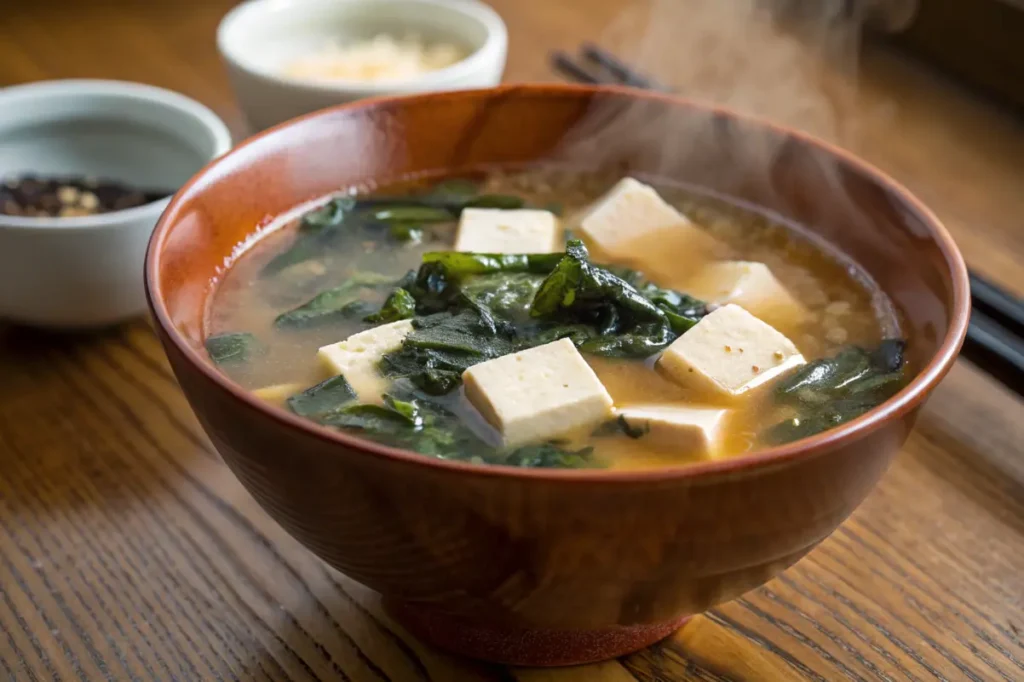
Miro soup calories – Discover the calorie content of miso soup and learn about its nutritional benefits, variations, and how it fits into a healthy diet.
1. Introduction
Miso soup is a staple of Japanese cuisine, known for its comforting, umami flavor. But for those who are conscious about their diet, understanding miso soup calories is important. Whether you’re trying to lose weight, maintain your current weight, or simply eat healthier, understanding the nutritional aspects of this traditional dish can help you make informed choices.
In this article, we’ll dive into the calorie count of miso soup, break down its ingredients, and explore how it can fit into a balanced diet. We’ll also address common questions and concerns regarding the calorie content, nutritional benefits, and how to make miso soup as healthy as possible. Additionally, we’ll provide insights into the different variations of miso soup and how their calorie content can vary.
Learn more about the health benefits of fermented foods.
2. What is Miso Soup?
2.1 A Traditional Japanese Dish
Miso soup is a traditional Japanese dish that has been enjoyed for centuries. It consists mainly of dashi broth, miso paste, tofu, and seaweed. Despite its simplicity, miso soup is rich in flavor and provides various health benefits. Moreover, its ease of preparation makes it a popular choice for many.
2.2 Common Ingredients in Miso Soup
- Miso Paste: The base of miso soup, miso paste, is made from fermented soybeans. It comes in different varieties, such as white (shiro) miso, red (aka) miso, and mixed (awase) miso. Each type has a unique flavor profile and calorie content.
- Dashi Broth: Dashi is the foundational stock made from kombu (kelp) and katsuobushi (fermented bonito flakes). It contributes to the umami flavor that miso soup is famous for. Additionally, dashi is low in calories, making it an excellent base for a healthy soup.
- Tofu: Tofu is a common addition, providing protein and a creamy texture. It also contributes to the overall nutritional value of the soup.
- Seaweed (Wakame): Seaweed adds a distinctive flavor and essential nutrients, such as iodine. It is also very low in calories, making it a great addition to miso soup.
Learn more about dashi and its role in Japanese cooking.
3. Miso Soup Calories Breakdown
3.1 Average Calorie Count
The calorie content of miso soup largely depends on the ingredients used. On average, a standard bowl of miso soup (about 1 cup or 240 ml) contains between 30 to 50 calories. The exact calorie count can vary depending on the type of miso paste, the quantity of tofu, and any additional ingredients such as vegetables or proteins.
- White Miso Soup: Typically contains fewer calories, around 35 per serving, due to its lighter fermentation process.
- Red Miso Soup: Contains slightly more calories, around 45 per serving, due to the higher fermentation content.
- Mixed Miso Soup: A combination of white and red miso, which typically falls in the middle range, with about 40 calories per serving.
3.2 Calories by Ingredient
Let’s break down the approximate calorie count of each common ingredient in miso soup:
- Miso Paste: 1 tablespoon = 35 calories
- Dashi Broth: 1 cup = 5 calories
- Tofu: 1/4 cup = 20 calories
- Wakame Seaweed: 1 tablespoon = 5 calories
These ingredients together create a nutritious and low-calorie soup. However, adding more ingredients can significantly change the calorie content.
3.3 Factors Affecting Calorie Count
The calorie content in miso soup can vary based on:
- Type of Miso: White miso contains fewer calories compared to red miso because of its lighter fermentation process.
- Additional Ingredients: Adding vegetables, mushrooms, or proteins like shrimp can significantly increase the calorie count.
- Portion Size: Larger portions naturally contain more calories. It is important to control portion size to manage calorie intake effectively.
4. Nutritional Benefits of Miso Soup
4.1 Rich in Probiotics
Miso paste is a fermented food, meaning it contains beneficial probiotics that support gut health. Probiotics can improve digestion and boost your immune system. Furthermore, they may contribute to better mental health, as recent studies suggest a link between gut health and mood regulation.
4.2 Low in Calories but Nutrient-Dense
With only 30 to 50 of calories per serving, miso soup is a low-calorie dish that still packs a nutritional punch. It contains essential vitamins and minerals like vitamin K, manganese, and zinc. Moreover, the addition of seaweed contributes to the iodine content, which is crucial for proper thyroid function.
4.3 Source of Protein
The tofu in miso soup provides plant-based protein, making this dish an excellent option for vegetarians. Additionally, the combination of seaweed and tofu provides a balanced amino acid profile. Protein helps in maintaining muscle mass and keeps you full for longer, which is particularly beneficial for those aiming to lose weight.
5. Miso Soup Calories: Impact on Weight Loss
5.1 Can Miso Soup Help with Weight Loss?
Miso soup is low in calories, making it a good choice for those looking to reduce their calorie intake. It is often included in weight loss plans because it is filling without being calorie-dense. Additionally, it is a great way to add flavor to a meal without excessive calories.
- Low Calorie Density: Since miso soup contains mostly water, it helps you feel full while consuming fewer calories.
- Rich in Protein: The tofu in miso soup adds protein, which can help keep you satisfied for longer periods. Protein also helps in muscle repair and growth, which is important when you are working out as part of a weight loss plan.
Discover more weight loss-friendly soups.
5.2 Portion Control
While miso soup is low in calories, portion control is still important. Consuming multiple servings with additional ingredients like noodles or seafood can quickly add up in calories. Moreover, it is essential to be mindful of the sodium content, as miso paste is quite high in sodium, which can lead to water retention if consumed in excess.
6. Different Types of Miso Soup and Their Calories
6.1 White Miso Soup
White miso soup is made using white miso paste, which is lightly fermented. It has a sweeter flavor and fewer calories compared to other types. A standard serving has about 35 calories. White miso is ideal for those who prefer a milder taste and are looking to keep the calorie content as low as possible.
6.2 Red Miso Soup
Red miso is more robust due to its longer fermentation process, which also increases its calorie content slightly. A serving of red miso soup contains about 45 to 50 calories. The rich, umami flavor of red miso makes it a great option for those who enjoy a stronger taste.
6.3 Custom Variations and Their Calorie Impact
- Vegetable Miso Soup: Adding vegetables such as carrots, onions, or spinach will increase the calorie content slightly, depending on the quantity. For example, adding half a cup of spinach adds approximately 5 calories, while adding half a cup of carrots adds 25 calories.
- Seafood Miso Soup: Adding shrimp, clams, or fish adds protein but also increases the overall calorie count. A serving of shrimp adds about 30 calories, while clams add around 40 calories.
- Miso Soup with Noodles: Adding udon or soba noodles can significantly raise the calorie count, with each serving of noodles adding approximately 100 to 200 calories. Noodles make the soup more filling, but they also make it more calorie-dense.
7. Tips for Making Low-Calorie Miso Soup
7.1 Choosing Low-Calorie Ingredients
- Less Miso Paste: Reduce the amount of miso paste to lower the sodium and calorie content.
- More Vegetables: Add low-calorie vegetables like spinach, mushrooms, and zucchini to bulk up your soup without adding many calories.
- Tofu Alternatives: Replace tofu with more vegetables if you want to reduce the calorie count even further. Vegetables like mushrooms provide a similar texture to tofu while being lower in calories.
7.2 Cooking Techniques for a Healthier Soup
- Avoid Overboiling Miso: Overheating miso can kill beneficial probiotics. Therefore, add miso paste to warm (not boiling) dashi to preserve nutrients.
- Use Low-Sodium Dashi: Opt for low-sodium dashi to make the soup healthier, especially if you’re concerned about sodium intake. Additionally, reducing the amount of miso paste can help lower the overall sodium content.
8. Frequently Asked Questions (FAQs)
Is miso soup healthy for weight loss?
- Yes, miso soup is healthy for weight loss because it is low in calories and high in nutrients, making it a satisfying option for reducing calorie intake. Furthermore, it helps in keeping you full without adding too many calories.
How many calories are in a bowl of miso soup?
- A standard bowl of miso soup contains between 30 to 50 calories, depending on the ingredients used.
Is miso soup the healthiest soup?
- Miso soup is one of the healthiest soups, especially due to its probiotic content, vitamins, and minerals. However, like all foods, it should be consumed in moderation to maintain a balanced diet.
Can miso soup be high in calories?
- Yes, miso soup can be high in calories if additional ingredients like noodles, seafood, or extra tofu are added. Portion size and ingredient choices greatly affect the calorie count. Therefore, it is important to customize the soup carefully to keep it within your desired calorie range.
9. Conclusion
Miso soup is a nutritious, low-calorie dish that can be a valuable addition to a healthy diet. Understanding miso soup calories can help you make informed dietary choices, whether you’re aiming for weight loss or simply trying to eat healthier. With various types of miso and endless customization options, this versatile dish is both satisfying and adaptable to different nutritional needs. Additionally, the probiotics in miso soup can support gut health, making it a great option for those looking to improve their digestive health.
In the next section, explore how you can make your own variations of miso soup with different ingredients and flavor profiles. Enjoy experimenting, and don’t forget that even small changes can make a big difference in the final calorie count. Furthermore, consider incorporating miso soup into your weekly meal plan for a nutritious and comforting addition.
After breakfast you need a delicious lunch ; Pasta with Lemon Butter Sauce and Basil Recipe Easy & Delicious



3 thoughts on “Miso Soup Calories | Nutritional Information and Health Benefits”